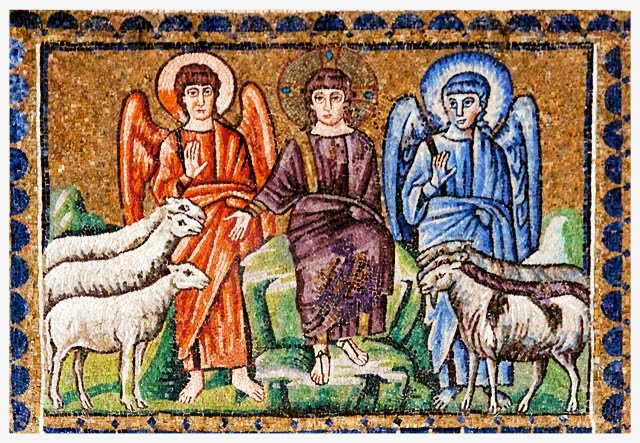Chapter Talk – Fifth Sunday of Easter – May 10, 2020, cycle-A
I have been reading Bonnie Thurston’s book, Shaped By the End You Live For. She quotes material from Thomas Merton that I have not read before and you will hear more of these pithy texts in a moment. I like to return to the ‘false self – true self’ dynamic that was important to Merton’s journey and to his understanding of monastic, contemplative life. Recalling our brief discussion several weeks ago I chose not to use the word ‘dichotomy’ in terms of the false self-true self relationship, so as not to give the sense that there is a split between these two realities. (However, one nuance of the word ‘dichotomy’ is contrast). Indeed, both are part of who we are. Through the false self we are immersed in illusion, in half-truths or untruths about ourselves and others. We don’t see as God sees or feel with the same heart as Christ. The false or illusory self sees the ‘mote’ or ‘sliver’ in one’s sister or brother’s eye but is blind to its own ‘beams’. It seems so much easier to criticize our neighbor than to put the gaze first upon our own heart. Last week I noted that Merton said ‘prayer itself is obedience’, a profound insight and one that essentially means that contemplative prayer is surrender…surrender to the silence…surrender into an empty space, where we wait and listen with the ‘ear of the heart’ for God’s word of life. This same word ‘surrender’ is important also in the process of finding our true self. Let me throw out another traditional image to help us get a sense of ‘false and true’: ‘purity of heart’. This is our immediate goal on the journey and this immediate goal, ‘purity of heart’, always leans into the final goal, the fullness of God’s life and truth. Can we not sense when our heart’s intention is true? Another essential saying of Jesus that elucidates the process of finding our true self is the great paradox: ‘whoever loses his life, or whoever dies to his self, will find life or will find her true self’ (Mk 8:35).
To continue on this theme, here is another potent saying of Thomas Merton, which again he said or wrote about towards the end of his life: “Prayer and identity go together” (p.113). Have you ever made this connection: that our prayer helps to form and shape our identity, our authentic self? We have heard the saying: how you pray reveals something of who you are. Our demeanor or inner attitude in prayer is mirrored in our active life. Prayer and how we live are to be one. This is essential for monastic life. We have the story in Luke’s gospel of the two men who go up to the temple to pray: one a Pharisee and the other a Publican (Lk 18:9-14). One prays for God’s mercy upon him a sinner, the other thanks God as he recounts all his good deeds and notes that he is not like this sinner here by his side. In this story Jesus gives two attitudes: one is humble and turns to God, the other is filled with himself. So how do I pray? What is my interior attitude when I pray? Am I able to go deeper than all those murmurings? Prayer is an encounter with the One who said: “I am the Way, the Truth, and the Life” (Jn 14:6). Within the silence of contemplative prayer, if we take a distance from our many thoughts and words that emerge in the encounter, we will meet the One whom we are seeking and we, as well, will meet ourselves in the truth of the God whom we encounter.
This Merton saying follows or builds on the previous text: “For us religious and contemplatives there is no identity crisis because our identity is found in our response to Christ” (p.114). The key here is ‘our response to Christ’. In other words, the more Christ-like we are in our actions, our truer self will be present. Our relationship with Christ faces us with those parts of ourselves that one could say are ‘false’ or inauthentic, aspects that keep us in the center and not God. Does it not seem ‘easier’ to listen to my many words and thoughts than surrender them and wait for the Divine word or the Divine touch of love and mercy? If we give ourselves to the One who we are following, the Way, the One who reveals Truth and compassionately shows us our ‘truth’, we will find Life, God’s life and our own true life.
Merton continues on the theme of ‘prayer and identity’: “The ground of identity is the sense of having been chosen by Christ” (p.114). This statement of Merton’s does not mean only a few are chosen. Every person is ‘chosen’, every person is called by God. This sense or experience of being ‘called’ becomes the ground of our identity. It becomes the foundation of our choice making in small and large ways. It puts us in relationship with God and sets up an on-going encounter with the Divine life, that becomes the source of our growth, our becoming more Christ-like in word and deed.
And one more final text from Merton: “The real meaning of our life is to develop people who really love God and who radiate love…For that they have to be fully unified and fully themselves” (p.114). To be ‘fully unified, fully ourselves’…this is the journey we are all on: to become more unified and more ourselves, within and without,…The good news is that prayer is one essential practice that will bless each of us a little more each day with the gift of ourselves, our true selves, if we are present in the same ‘kenosis’ as Jesus was in his prayer and in his life. Surrender, self-emptying purifies the heart and mind and gifts one with the Divine life, Christ’s life and truth. While self-knowledge is an important monastic value, it seems to me that it needs to be accompanied with prayer. The grace of prayer is that grace gets each bit of self-knowledge to stick, to root in our hearts and in our consciousness. In prayer, we meet a God that has ‘loved us first’ and continues to love us, continues to love our whole selves, our imperfect selves with both their weaknesses and strengths. No wonder that Merton says: “Prayer and identity go together.”
Sr. Kathy DeVico, Abbess


